Fast Facts
- When: 26th August to 8th September 2024
- Where: Billie Jean King National Tennis Centre, Flushing Meadows, New York
- Watch: Sky Sports
- Official Website: US Open
The US Open makes up the final part of the four Grand Slams that take place throughout the year for tennis players, after the Australian Open, French Open and Wimbledon.
As a Grand Slam it is thought of as one of the biggest prizes in the game and, in a normal season, as the last major it represents the final shot the players have at getting their name into the tennis history books that year.
There’s usually a few decent offers for this tournament, including in-play free bets and acca insurance. Plus the occasional enhanced odds or money back offer on the outright winner markets.
Existing Customer Free Bets & Money Back Offers
Note: Offers will appear here nearer the event as and when they become available.
Stats Articles
- How Many Qualifiers & Unseeded Players Have Won a Tennis Major?
- How Often Do Tennis Players Lose After Going 2 Sets Up in the Grand Slams?
- Grand Slam Winners in Tennis: Which Players Have Won All Four Major Tournaments?
Event Stats
US Open Men’s Singles Finals – 2014 to 2023
| Year | Winner | Runner-Up | Score | Losing Semi-Finalists |
|---|---|---|---|---|
| 2023 | Novak Djokovic (2) | Daniil Medvedev (3) | 3-0 | B. Shelton (-), C. Alcaraz (1) |
| 2022 | Carlos Alcaraz (3) | Casper Ruud (5) | 3-1 | F. Tiafoe (22), K. Khachanov (27) |
| 2021 | Daniil Medvedev (2) | Novak Djokovic (1) | 3-0 | F. A-Aliassime (12), A. Zverev (4) |
| 2020 | Dominic Thiem (2) | Alexander Zverev (5) | 3-2 | D. Medvedev (3), P. C-Busta (20) |
| 2019 | Rafael Nadal (2) | Daniil Medvedev (5) | 3-2 | M. Berrettini (24), G. Dimitrov (-) |
| 2018 | Novak Djokovic (6) | JM del Potro (3) | 3-0 | K. Nishikori (21), R. Nadal (1) |
| 2017 | Rafael Nadal (1) | Kevin Anderson (28) | 3-0 | JM. del Potro (24), P. C-Busta (12) |
| 2016 | Stan Wawrinka (3) | Novak Djokovic (1) | 3-1 | K. Nishikori (6), G. Monfils (10) |
| 2015 | Novak Djokovic (1) | Roger Federer (2) | 3-1 | M. Cilic (9), S. Wawrinka (5) |
| 2014 | Marin Cilic (14) | Kei Nishikori (10) | 3-0 | R. Federer (2), N. Djokovic (1) |
US Open Women’s Singles Finals – 2014 to 2024
| Year | Winner | Runner-Up | Score | Losing Semi-Finalists |
|---|---|---|---|---|
| 2023 | Coco Gauff (6) | Aryna Sabalenka (2) | 2-1 | K. Muchova (10), M. Keys (17) |
| 2022 | Iga Swiatek (1) | Ons Jabeur (5) | 2-0 | A. Sabalenka (6), C. Garcia (17) |
| 2021 | Emma Raducanu (Q) | Leylah Fernandez (-) | 2-0 | M. Sakkari (17), A. Sabalenka (2) |
| 2020 | Naomi Osaka (2) | Victoria Azarenka (-) | 2-1 | J. Brady (28), S. Williams (3) |
| 2019 | Bianca Andreescu (15) | Serena Williams (8) | 2-0 | B. Bencic (13), E. Svitolina (5) |
| 2018 | Naomi Osaka (20) | Serena Williams (17) | 2-0 | M. Keys (14), A. Sevastova (19 ) |
| 2017 | Sloane Stephens (-) | Madison Keys (15) | 2-0 | V. Williams (9), C. V’weghe (20) |
| 2016 | A. Kerber (2) | K. Pliskova (10) | 2-1 | C. Wozniacki (-), S. Williams (1) |
| 2015 | Flavia Pennetta (26) | Roberta Vinci (-) | 2-0 | S. Halep (2), S. Williams (1) |
| 2014 | Serena Williams (1) | C. Wozniacki (10) | 2-0 | E. Makarova (17), P. Shuai (-) |
Schedule
- 1st Round – Monday 26th & Tuesday 27th August 2024
- 2nd Round – Wednesday 28th & Thursday 29th August 2024
- 3rd Round – Friday 30th & Saturday 31st August 2024
- Round of 16 – Sunday 1st & Monday 2nd September 2024
- Quarter Finals – Tuesday 3rd & Wednesday 4th September 2024
- Women’s Semi Finals – Thursday 5th September 2024
- Men’s Semi Finals – Friday 6th September 2024
- Women’s Final – Saturday 7th September 2024
- Men’s Final – Sunday 8th September 2024
Schedule subject to confirmation
About the US Open
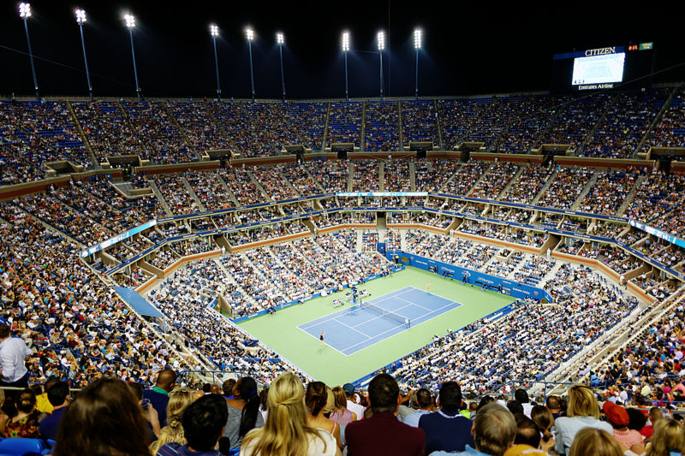
The US Open takes place at the Billie Jean King National Tennis Centre in New York. It’s held on the last Monday in August, which also ties-in with the height of the US summer, meaning that the heat of the tournament is as big a factor as any for the players. In fact, in more recent years, the tournament has seen ‘sun breaks’ introduced, where matches are paused should a certain temperature be reached.
There are twenty-two courts available for use during the US Open at Flushing Meadows, which was renamed after four-time champion Billie Jean King in 2006. There are four main courts, thirteen outside courts and five courts that are available for practice games. Arthur Ashe Stadium opened in 1997 and can host more than twenty-two thousand spectators. It is named after the African American tennis player Arthur Ashe, who won the first ever US Open of the new era in 1968. The Louis Armstrong Stadium opened in 1978 and was the main stadium used up until 1996. It originally had a peak capacity of around eighteen thousand seats, seeing that reduced to just over ten thousand when the upper-tier was removed upon the opening of the Arthur Ashe Stadium.
The other two ‘show courts’ comprise firstly of the Grandstand, which is a six thousand seat arena that was created when the Singer Bowl became the Armstrong Stadium. That’s because the Singer Bowl was rectangular but the Louis Armstrong was square, meaning that there was some leftover space for another venue to be created. The final of the main arenas is Court 17, which has large televisions screens inside it and an electronic line-calling device that allows players to make challenges. It can hold three thousand spectators and has earned the nickname ‘the pit’ on account of the fact that it’s sunken into the ground. The rest of the courts around the venue are all illuminated in order to allow television coverage of matches to carry on into the evening and the famed American ‘primetime slot’.
Hard Court Surface
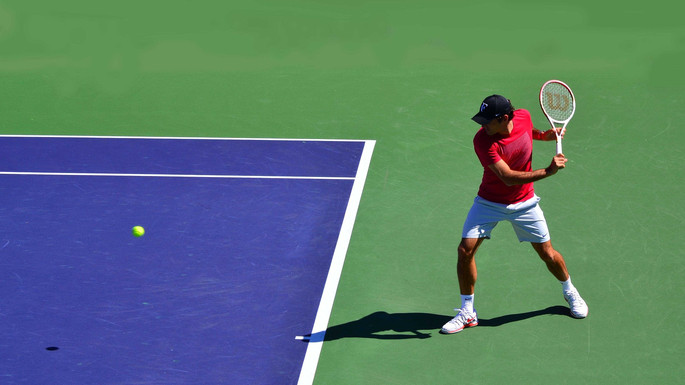
In terms of the surface used at the US Open, it has changed numerous times over the years. Originally played on grass, clay was used for a time when the tournament took place at Forest Hills. It has been played on hardcourt ever since the event moved to Flushing Meadows and until 2020 the surface known as Pro DecoTurf was used. Since 2020, the court switched to a different hardcourt surface known as Laykold.
The ITF classify it as a ‘medium-fast (category 4) surface, given that it produces a slightly lower bounce than other hard court surfaces. As with so many things in US sports, a decision was taken in 2005 to make the inside of the court blue as it makes it easier for television audiences to see the ball. Hawk-Eye computer technology has been used since 2006, allowing players to challenge line calls. In 2021 the US Open used the system to run electronic automatic line calling, meaning there was no longer a need for line judges.
US Open Origins & History
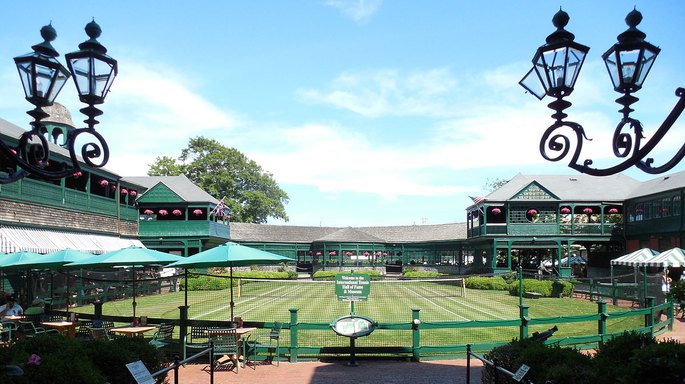
The first US Open took place in 1881 and was hosted in Newport, Rhode Island and initially played on grass. In the years that followed the tournament searched for a permanent home, taking in a number of venues including Germantown Cricket Club in Philadelphia and Forest Hills, before settling at the Billie Jean King National Tennis Centre in 1978.
Whilst the tournament has been running in some form since 1881, it wasn’t until 1968 that it became the US Open as we know it, allowing participants of both a professional and amateur status to compete, should they qualify. It’s also worth noting that, whilst the tournament was widely regarded as a Major since it’s inception, it was only officially recognised as one in 1924.
The Newport Casino Tournaments: 1881 – 1914
Though the tournament is nowadays known as an ‘Open’, which allows tennis players of any level to compete in it provided that they are eligible to do so, it began life as a far more exclusive affair. The event took place for the first time in August of 1881 and only players that were members of clubs that were part of the United States National Lawn Tennis Association were invited to take part in it. It’s also noteworthy that the women’s game wasn’t respected enough then to be part of the competition, meaning that only men could compete in it. The inaugural tournament was won by Richard Sears, who would go on to win a further seven titles in his career.
Part of the reason Sears was so successful was the tournament employed a ‘challenge’ system in those early years. That meant that the previous year’s winner automatically qualified for the final. In it he would face the winner of an ‘all-comers’ competition that took place to see who would earn the right to take him on. The event was hosted by the Newport Casino on its grass courts until it was moved to West Side Tennis Club at Forest Hills in New York in 1915, about four years after a group of tennis players had attempted to persuade the USNLTA to move it to the New York region.
The Addition of the Women’s Game: 1887
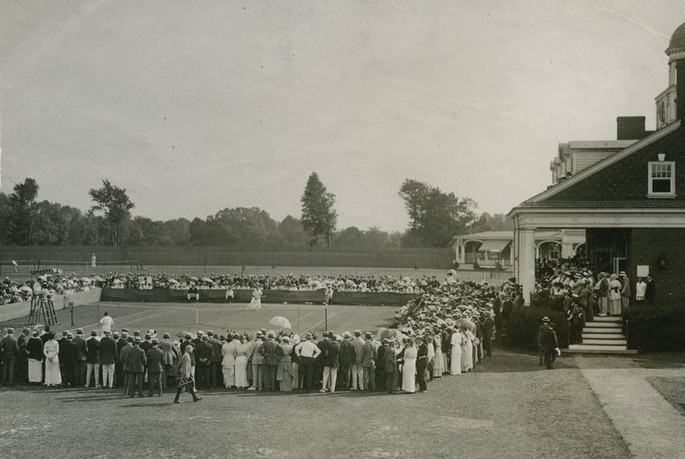
National Women’s Tennis Tournament at the Philadelphia Cricket Club, Wikimedia Commons
The tournament was originally known as the US National Singles Championships for Men, with the women’s game beginning its own comparative competition at the Philadelphia Cricket Club in 1887. That was won by a seventeen-year-old called Ellen Hansell, who was a native of Philadelphia. Five years later and the sport saw a Mixed Doubles Championship become the norm, with the U.S. Women’s National Doubles Championship beginning in 1899. As with the Men’s game, the Women’s tournament used a challenge system up until 1918, with the exception of in 1917.
From 1890 through to 1906, the Doubles tournament worked by having sectional tournaments take place in the west and east of the United States to find the best two Doubles teams. They then played against each other in a one-off match to determine who would have the right to play against the defending champions in the final. It took time for the Women’s and Men’s game to be combined into one tournament, but when you look at the stats of winners for the championships over the years you’ll see that they are split into two sections regardless. For male players there is the period of time from when the tournament first took place in 1881 through to when the Open era began in 1968, whilst for female players that time ranges from 1887 to 1968.
Relocation to Forest Hills, New York: 1915
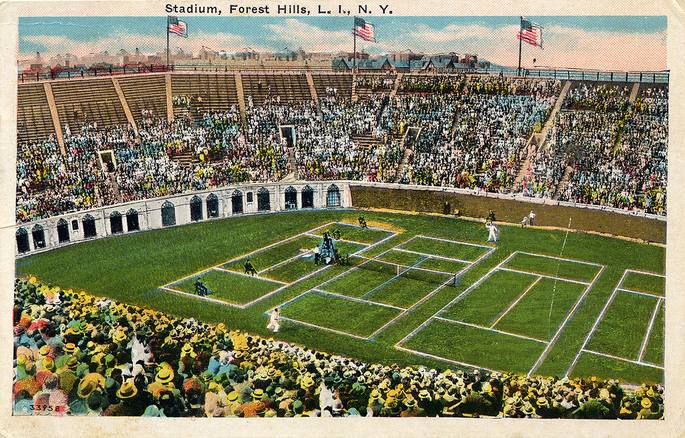
By Thomasmreilly, Wikimedia Commons
In 1915 a group of around one hundred players signed a petition arguing for a move to New York on account of the fact that most clubs, players and fans of the game were based in the city. It was felt that it was holding the game back to host the tournament anywhere other than in the epicentre of the sport, though another group, including eight former champions, disagreed. The USNLTA held a vote on the fifth of February 1915 and the decision to move was approved by a vote of one hundred and twenty-eight to one hundred and nineteen. The tournament was on its way to West Side Tennis Club, Forest Hills, New York.
The only problem with the move was the new site didn’t quite have the facilities to cope with the ever-more popular new tennis tournament. As a result, the competition was played at Germantown Cricket Club in Philadelphia between 1921 and 1923 and a new 14,000 seater stadium was built at Forest Hills. It was also during this time that seeding was introduced to the US National Championship for the first time, with the 1922 version of the event using it in order to keep the top players away from each other in the early rounds. When it returned to its New York home in 1924, the International Lawn Tennis Federation decided that it was time to officially designate it as a Major.
Becoming an Open: 1968
Prior to 1968, the US National Championship had been strictly an event for amateur tennis players. The clamour for that to change grew, specifically in-line with the other Majors around the world that were also seeing a call for professionals to be allowed to take part in them. The decision to ‘open’ the tournament up finally came about in 1968 when all of the events that were played at the Championship, so the Singles and Doubles of both sexes, were opened up to tennis players of any level. As a result, ninety-six men and sixty-three women entered the event and the prize money amounted to $100,000. The table below show the first five men’s and women’s singles champions of the open era.
| Year | Men’s Singles Champion | Women’s Singles Champion |
|---|---|---|
| 1968 | Arthur Ashe (USA) | Virginia Wade (GBR) |
| 1969 | Rod Laver (AUS) | Margaret Court (AUS) |
| 1970 | Ken Rosewall (AUS) | Margaret Court (AUS) |
| 1971 | Stan Smith (USA) | Billie Jean King (USA) |
| 1972 | Ille Nastase (ROM) | Billie Jean King (USA) |
Once the decision to make the event an Open was take, things moved quickly in the development of the competition. In 1970, for example, it became the first of the tennis Grand Slam events to use a tiebreaker for sets that reached 6-6. It was also the only one of the Majors to use a tie-breaker in the final set, with the other tournaments continuing to ask players to win the decisive set by two clear games. That’s a rule that Wimbledon continued to employ as recently as 2018. The tie-breaker system initially employed was one of nine-point sudden-death, not moving to the International Tennis Federation’s twelve-point sudden-death system until 1975. The innovations didn’t stop there, with Men and Women winners paid equal prize money from 1973 – the first Major to do so – and floodlights being used from 1975.
The USTA National Tennis Center: 1978 – Present
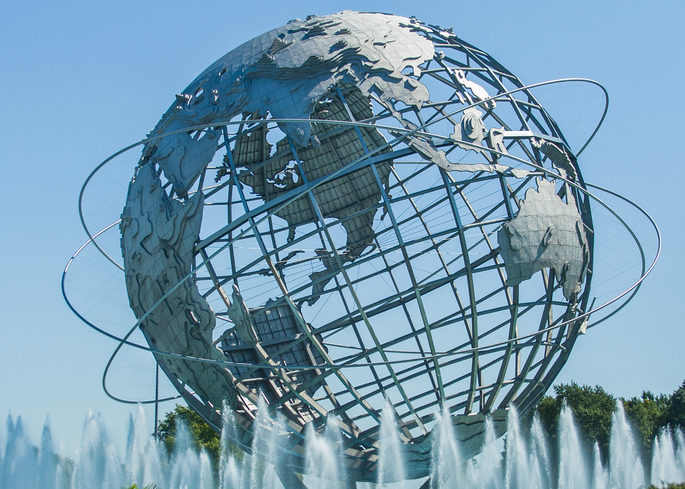
Unisphere Sculpture at Flushing Meadows by Paul VanDerWerf, flickr
Despite the work done to develop the Forest Hills club, it was never going to be able to cope with the demands of a tournament growing in popularity with every passing year unless major surgery and development was done to the venue. It made far more sense to move the competition to a new home entirely, with the United States Tennis Association’s National Tennis Centre at Flushing Meadows being the obvious choice. Located in the New York borough of Queens about three miles north of West Side Tennis Club, it had a hard court surface rather than the clay one that had been used for the final three years at Forest Hills. The decision to move there occurred in 1978 and between 1984 and 2015 the competition employed a schedule that became known as ‘Super Saturday’. That’s because the Women’s final and the Men’s semi-finals were held on the same day.
The decisions made by the USTA haven’t always pleased the Association of Tennis Professionals, however. In 2001, for example, the women’s final was moved to the Saturday night in order to accommodate a primetime tennis audience, meaning that the players had less than a day to prepare for the final after the end of the semi-finals. The men’s game, meanwhile, saw the final take place on the Monday five times consecutively between 2007 and 2012 because of weather. That couldn’t be avoided, but when the event’s organisers chose to have it played on the Monday night intentionally in 2013 and 2014 it was felt that it was causing the US Open to deviate too far from the structure of the other Majors. The decision was taken in 2015 to abandon the whole notion of a ‘Super Saturday’ and instead the tournament fitted in with the way the rest of the Grand Slams operate, with weather now being the only reason the semi-finals and finals might be moved around.
Tournament Format
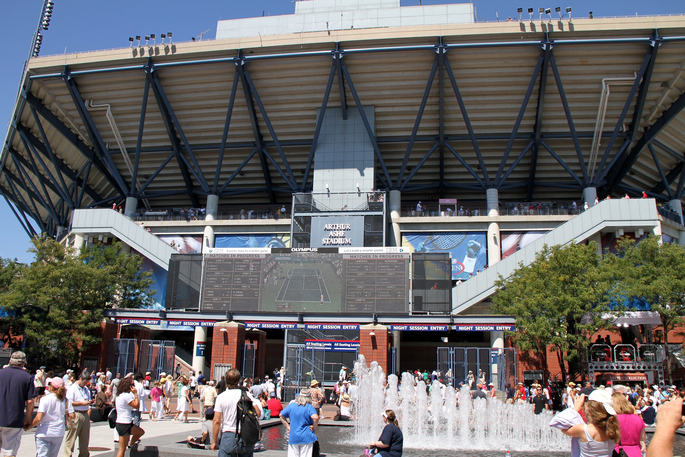
By Edwin Martinez, flickr
Qualification for the US Open is like many other open events before it. As mentioned, it’s a chance for both professionals and amateurs to play side-by-side and against each other, competing at the highest level.
The men’s and women’s games both include one hundred and twenty-eight starting participants. These are made up of a mix of players who have met qualifying criteria and also players who have managed to qualify by winning specific tournament related to the US Open.
Whilst the number of players who get in via each process varies, the standard is for around one hundred players to do so either via world ranking points, previous tournament winners or highest ranked money list players. The remaining players are made up of wildcards given out by the US Open committee and players who have won specific qualifying events.
The tournament uses a knockout format from the off, with players being seeded in order to ensure that the best ones don’t come up against each other until towards the final rounds of the event. That is the case with both the Men’s and Women’s game, as well as the Doubles and Mixed Doubles. The Women’s game is played in a best of three sets format, whilst the Men’s game is played over best of five sets.
As you might imagine, the US Open works in a similar way to other tennis tournaments in the sense that there is a different amount of prize money available to players depending on how far into the tournament they progress. In 2023 the total prize fund was $65 million up $4.9 million from 2023.
US Open Prize Money – 2023
| Round Reached | Men’s & Women’s Singles | Doubles (Per Partnership) |
|---|---|---|
| Round 1 | $81,500 | $22,000 |
| Round 2 | $123,000 | $36,800 |
| Round 3 | $191,000 | $58,000 |
| Round 4 | $284,000 | – |
| Quarter-Final | $455,000 | $100,000 |
| Semi-Final | $775,000 | $180,000 |
| Runner-up | $1,500,000 | $350,000 |
| Winner | $3,000,000 | $700,000 |
They also earn differing amounts of ranking points according to their success in the tournament, with the following table giving you an indication of proceedings as they were for the 2022 event.
US Open Ranking Points – 2023
| Round Reached | Men’s Singles | Women’s Singles | Men’s Doubles | Women’s Doubles |
|---|---|---|---|---|
| Round 1 | 10 | 10 | 0 | 10 |
| Round 2 | 45 | 70 | 90 | 130 |
| Round 3 | 90 | 130 | 180 | 240 |
| Round 4 | 180 | 240 | – | – |
| Quarter-Final | 360 | 430 | 360 | 430 |
| Semi-Final | 720 | 780 | 720 | 780 |
| Runner-up | 1,200 | 1,300 | 1200 | 1300 |
| Winner | 2,000 | 2,000 | 2,000 | 2,000 |
Interesting Facts
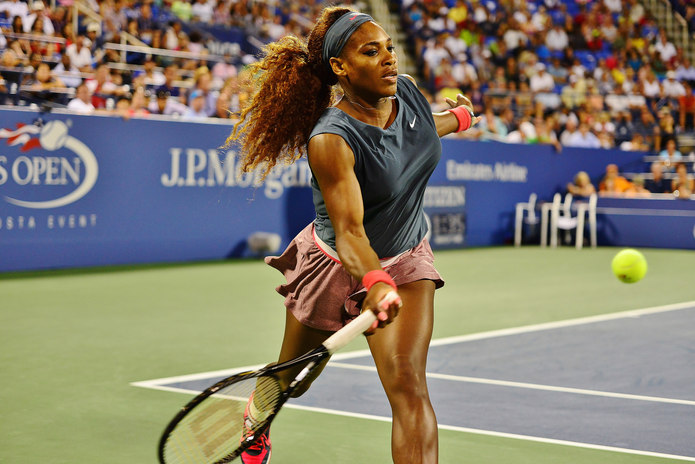
The majority of stats that are taken from the modern day era are those that are from 1968 onwards, when the US Open as we know it was first played. Whilst data is available for tournaments prior to this date, a lot of the records that you will see will be post 1968.
There are three men who have won the tournament a record five times in the Open era and these are Jimmy Connors, Pete Sampras and Roger Federer. Federer holds the record for the most consecutive singles titles as well, with all five of his coming from 2004 through to 2008.
Chris Evert and Serena Williams are the two most decorated female champions, with six US Open wins apiece. Evert actually won four of her titles in consecutive years from 1975 to 1978, setting the record in doing so.
There are, of course, plenty for other interesting facts, with the following being some of the standouts:
- Three men share the honour of winning seven titles pre-1968, namely Richard Sears, Bill Lamed and Bill Tilden
- Richard Sears is the competitions most successful male player ever, having also won six Doubles titles – tied with Holcombe Ward
- Molla Bjurstedt Mallory is the most successful woman of any era, having won the title eight times
- Margaret Osborne duPont is the most successful Women’s Doubles player, having picked up thirteen titles
- The youngest ever win of the Men’s title was Pete Sampras, who was nineteen years and one month old when he was victorious in 1990
- The youngest Women’s winner was Tracy Austin, who won the title as a sixteen-year and eight month old in 1979
- Conversely, the oldest Male victor was William Larned in 1911, winning at the age of thirty-eight years and eight months
- The oldest Female winner was the aforementioned Molla Bjurstedt Mallory, picking up the title in 1926 at the ripe age of forty-two-years and five months
- Mallory also appeared in more finals than any other female player, making the last match ten times between 1915 and 1926
- Ten is also the number of finals that Bill Tilden made it to in the Men’s game, doing so between 1918 and 1929
- In 2021, Britain’s Emma Raducanu became the first singles player to win a Grand Slam tournament after coming through the qualifiers
